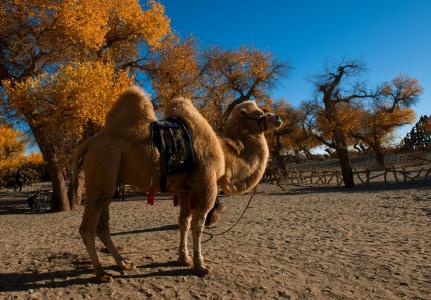Middle east and Africa: East African camels: Speedy and tasty
中東和非洲:東非駱駝:又快又有味兒
The camel trade is increasingly lucrative.
駱駝貿易越來越獲益。
“Allahu akbar!” the boys shout gleefully from atop their camels, the reins of others held in their raised fists, their backs to the setting sun.
“真主至大!”一群男孩坐在駱駝背上開心地喊著,高舉的拳頭里攥著其它駱駝的韁繩,背向夕陽而行。
Beside them a metal-fenced racing track cuts through the pancake-flat desert.
不遠處,金屬柵欄圍起的賽道穿過薄餅般平坦的沙漠。
Every dawn and dusk the camels are trained to run on this plain outside Kassala, a city in eastern Sudan.
這塊大平地位于蘇丹東部城市卡薩拉的城外,那些駱駝每天早晚都在這兒接受賽跑訓練。

Their owners hope they will catch the eye of the wealthy Emiratis who visit several times a year to buy the fastest mounts for multi-million-dollar prize races in Dubai.
養駱人都希望自家的駱駝能夠吸引一些富有的阿聯酋人的注意,那些有錢人一年會來這好幾次,購買跑得最快的駱駝去參加迪拜的百萬美元駱駝賽。
The Rashaida, a tribe that migrated to Sudan and Eritrea from Saudi Arabia in the mid-19th century, are renowned for breeding some of the world’s speediest racing camels.
拉舍達是19世紀中葉從沙特阿拉伯移居到蘇丹和厄立特里亞的一個部落,以培育世界上跑得最快的比賽駱駝而聞名。
They are also in famous for trafficking Eritreans who cross the border, around 30km (20 miles) from Kassala, in the hope of eventually reaching Europe.
他們也因販賣厄立特里亞人而臭名昭著,那些被拐的人原本是想穿越卡薩拉30千米(20英里)外的邊界并最終抵達歐洲。
Emiratis buy between 100 and 300 young camels a year from the village of Abu Talha, some for as much as $80,000, says Hamed Hamid, a mustachioed patriarch.
大胡子族長Hamed Hamid稱,阿聯酋人每年從Abu Talha村中購買100到300匹小駱駝,有些賣到8萬美元一匹。
There are around 800 racing beasts in a settlement of 1,200 people, he estimates, and many more are being raised for slaughter.
據他估算,1200戶人口的村子里約有800匹比賽駱駝,供宰殺的駱駝數量更多。
“The camels are everything. They give us milk, meat and trade,” Mr Hamid says, as his wife brews tea and coffee over hot coals under a starry sky.
Hamid說:“駱駝就是一切。它們為我們提供駱駝奶、駱駝肉,并帶來貿易機會”,他說這話時,他的妻子正在熱炭上煮著茶和咖啡,頭上是滿天的繁星。
Although the Rashaida are traditionally nomadic, many have settled in villages like Abu Talha, a jumble of earthen-walled or brightly painted concrete houses.
盡管拉舍達人是傳統的游牧民族,但很多人已在如Abu Talha之類的村莊中定居下來,村莊里雜亂排布著泥墻房或色彩鮮艷的混凝土房。
They have also adapted to the United Arab Emirates’ ban on child jockeys, after the state was censured by the UN in 2005.
2005年,聯合國譴責阿拉伯聯合酋長國讓兒童當駱駝騎師,隨后阿聯酋出臺相關禁令,拉舍達人也已經接受了這個禁令。
Boys still train some camels, but others are whipped along by miniature robots dressed in jockey silks and given orders remotely from white Toyota pickup trucks.
雖然仍有少量駱駝由男孩帶領著訓練,但大部分駱駝已由微型機器人打鞭驅策,這些機器人穿著彩色絲綢騎師服,遠程接收隨行的白色豐田皮卡的指令。
Each month the villagers sell around 200 baby camels to Saudi Arabia and 120 adult ones to Egypt for human consumption, says Mr Hamid, pointing out a large female that will fetch as much as 25,000 Sudanese pounds ($1,525 at the black-market exchange rate) .
Hamid說,每個月村民向沙特阿拉伯售出約200匹駱駝幼崽,向埃及售出約120匹成年駱駝以供食用。據他透露,一匹大的母駱駝能賣2.5萬蘇丹鎊(以黑市匯率計算約合1,525美元)。
Livestock is a big and growing business all over east Africa, in considerable part fuelled by the Gulf’s increasing appetite for meat.
在整個東非地區,牲畜貿易都是大買賣,近年來發展迅速,很大程度上源于海灣國家對駱駝肉的需求上漲。
Live Sudanese animal exports more than trebled to $670m between 2010 and 2013 (the most recent years for which the World Bank has data) .
2010年至2013年間(這是世界銀行的最新數據),蘇丹的活牲畜出口額翻了三倍多,達6.7億美元。
More than 70% were sheep, demand for which surges around the Muslim festival of Eid al-Adha, when they are ceremonially slaughtered.
其中70%以上是羊,羊的需求量會在穆斯林古爾邦節來臨之際大漲,因為那時候這些羊會作為節日祭品宰殺。
In 2015 Somalia sold 5.3m animals, worth $384m; livestock counts for 40% of that fractured country’s GDP.
2015年,索馬里售出530萬頭牲畜,價值3.84億美元;牲畜業占到這個支離破碎的國家的國內生產總值的40%。
Other Sudanese may sneer that the Rashaida’s new cars and houses have been bought with the proceeds of people-smuggling.
其它蘇丹人可能會嘲笑拉舍達人的新車子新房子是販賣人口賺來的。
But there is plenty of money to be made in the legitimate business of exporting livestock.
但事實上,不少錢是通過牲畜出口貿易合法賺來的。



